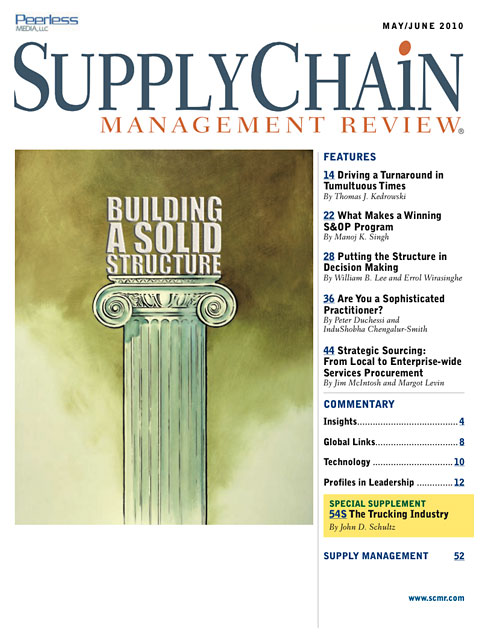Sorry, but your login has failed. Please recheck your login information and resubmit. If your subscription has expired, renew here.
May-June 2010
Spring is a time for renewal. It's a time for re-assessing the way we've been doing things and making changes in a manner that ensures forward progress. That's a recurring theme of the articles in the May/June issue of Supply Chain Management Review. With the building blocks in place and the spirit of renewal in full bloom, who knows what level of supply chain excellence can be achieved? Browse this issue archive.Need Help? Contact customer service 847-559-7581 More options
There is simply no other word for it. The success rate for Sales & Operations Planning (S&OP) programs has been dismal. A third of all S&OP programs fail or produce unclear results.
That is one of the most worrying findings for a survey SCMR ran last year to better understand the impact of the recession from the viewpoints of supply chain executives. The survey, conducted on behalf of IBM and Oracle, showed that about 40 percent of businesses don’t even have a formal S&OP program in place. And it revealed some staggering gaps in the participation of different stakeholders where S&OP processes do exist. Nearly half of the supply chain managers polled conceded that they run their S&OP meetings without regular participation form their companies’ manufacturing and finance departments. More than 50 percent do not involve anyone from marketing.
What’s going on? After all, the S&OP process was designed around close collaboration between such stakeholders. The concept is simple: By regularly getting those who have the most visibility of demand at the same table with those who have the best insights into constraints on the supply side, companies are supposed to be able to build better supply chain plans and to collaborate more effectively to implement those plans.
The idea is not new. It has been around since the 1980s. If done right, S&OP has the potential to significantly improve some key operational metrics. According to the research firm the Aberdeen Group, companies that demonstrate best-in-class S&OP have 91 percent complete order fill rates and logistics costs of as little as 6 percent of sales. And their gross margins average 43 percent.
So the basic question is this: Why don’t companies adopt this apparently simple concept?
 |
This complete article is available to subscribers
only. Click on Log In Now at the top of this article for full access. Or, Start your PLUS+ subscription for instant access. |
Not ready to subscribe, but need this article?
Buy the complete article now. Only $20.00. Instant PDF Download.
Access the complete issue of Supply Chain Management Review magazine featuring
this article including every word, chart and table exactly as it appeared in the magazine.
SC
MR
Sorry, but your login has failed. Please recheck your login information and resubmit. If your subscription has expired, renew here.
May-June 2010
Spring is a time for renewal. It's a time for re-assessing the way we've been doing things and making changes in a manner that ensures forward progress. That's a recurring theme of the articles in the… Browse this issue archive. Download a PDF file of the May-June 2010 issue. |
Download Article PDF |
There is simply no other word for it. The success rate for Sales & Operations Planning (S&OP) programs has been dismal. A third of all S&OP programs fail or produce unclear results.
That is one of the most worrying findings for a survey SCMR ran last year to better understand the impact of the recession from the viewpoints of supply chain executives. The survey, conducted on behalf of IBM and Oracle, showed that about 40 percent of businesses don’t even have a formal S&OP program in place. And it revealed some staggering gaps in the participation of different stakeholders where S&OP processes do exist. Nearly half of the supply chain managers polled conceded that they run their S&OP meetings without regular participation form their companies’ manufacturing and finance departments. More than 50 percent do not involve anyone from marketing.
What’s going on? After all, the S&OP process was designed around close collaboration between such stakeholders. The concept is simple: By regularly getting those who have the most visibility of demand at the same table with those who have the best insights into constraints on the supply side, companies are supposed to be able to build better supply chain plans and to collaborate more effectively to implement those plans.
The idea is not new. It has been around since the 1980s. If done right, S&OP has the potential to significantly improve some key operational metrics. According to the research firm the Aberdeen Group, companies that demonstrate best-in-class S&OP have 91 percent complete order fill rates and logistics costs of as little as 6 percent of sales. And their gross margins average 43 percent.
So the basic question is this: Why don’t companies adopt this apparently simple concept?
 |
SUBSCRIBERS: Click here to download PDF of the full article. |
SC
MR

Latest Supply Chain News
Latest Podcast

 Explore
Explore
Latest Supply Chain News
- 2024 Warehouse/DC Operations Survey: Technology adoption on the rise
- Benchmarking the complexity of ESG reporting
- Looking back at NextGen 2024
- The Corporate Sustainability Due Diligence Directive
- How to make your CFO a supply chain superfan
- AI is moving omnichannel closer to the customer
- More latest news
Latest Resources

Subscribe

Supply Chain Management Review delivers the best industry content.

Editors’ Picks





